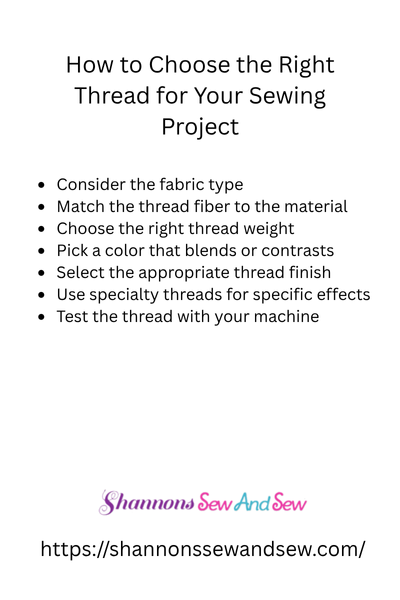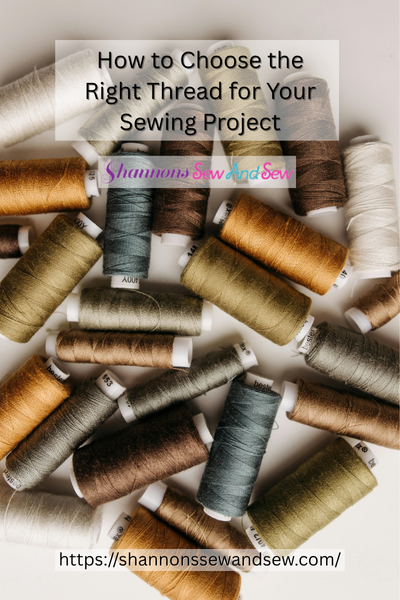Supplies And Equipment
How to Choose the Right Thread for Your Sewing Project
How to choose the right thread for your sewing project—if you’ve ever stood in front of that wall of spools wondering if polyester or cotton is about to make or break your masterpiece, you’re definitely not alone. I’ve been there. Staring. Sweating. Second-guessing.
And let me tell you, choosing the wrong thread? Yeah, it can turn your whole project into a total mess. Trust me—I once used upholstery thread to hem a T-shirt. It was… not great.
So let’s save you from that kind of DIY disaster.
Read More About How to Choose the Right Thread for Your Sewing Project

Why Thread Really Does Matter
I used to think thread was just thread. Pick a color, match it to the fabric, and you’re good to go, right? Nope. That’s like saying oil is just oil—try putting motor oil in your salad and see how that works out. (Please don’t actually do that.)
When you’re figuring out how to choose the right thread for your sewing project, you’re not just picking a color. You’re picking strength, stretch, texture, and even the longevity of your work. Thread holds it all together—literally. The wrong choice might fray, snap, or even mess with your tension settings.
More Things to Know About How to Choose the Right Thread for Your Sewing Project

Start with Your Fabric (Always)
Here’s the golden rule I go by: the thread should match the weight and behavior of your fabric. Sewing a heavy canvas tote? Lightweight cotton thread won’t cut it. Making a slinky knit top? You’ll want something with a bit of stretch, like polyester or wooly nylon.
One time I tried using a standard cotton thread on a stretchy rayon dress, thinking I could “make it work.” Spoiler alert: I could not make it work. Popped seams everywhere. It looked like my dress was going through a breakup.
So think fabric first. What’s it like? Thick and structured? Soft and stretchy? Shiny or matte? That helps you narrow down the right thread.
Let’s Talk Thread Types (But Keep It Simple)
Okay, I promised no jargon—so I won’t bore you with fiber blends and tensile strength. But here’s a quick peek at your usual suspects:
- Cotton thread: Great for natural fabrics like linen and—surprise—cotton. It doesn’t stretch much though, so keep it off your knits.
- Polyester thread: Your everyday hero. It’s strong, a little stretchy, and works well with most fabrics.
- Nylon thread: Often used for things like activewear or upholstery—tough and stretchy but can melt under high heat (hello, scorched seams).
- Silk thread: Fancy, smooth, and perfect for hand sewing or delicate fabrics.
- Topstitching thread: Thicker and flashier, used for visible stitches on jeans or bags.
So when you’re wondering how to choose the right thread for your sewing project, start by matching your thread’s vibe to your fabric’s attitude. Rugged canvas? Go sturdy. Flowy chiffon? Go silky.
Color Isn’t Just for Looks
I know, color is the fun part. You line up your swatches, hold up spools, squint and tilt your head like you’re judging art. (It’s kind of fun, right?)
But color choice does more than just match—it can make or break the final look. Here’s my tip: If you’re between two shades, go darker. It blends in better than a lighter one. Or if you’re feeling wild? Contrasting thread can make your seams pop—in a good way.
One time I used bright red thread on navy blue denim for a jacket. It looked bold, intentional, and honestly… kind of badass.
A Quick Note on Spool Quality
Not all threads are created equal. I’ve used a bargain bin thread before and regretted every second. It tangled, frayed, and left enough lint in my machine to knit a sweater.
Look for a smooth, consistent thread. If it feels fuzzy, it probably is fuzzy—and that means breakage and jammed machines.
You don’t have to buy the fanciest brand, but avoid the sketchy off-brand stuff that feels like it came from a Halloween costume kit.
Don’t Forget Your Needle!
Okay, I know this post is about how to choose the right thread for your sewing project, but let me sneak in one quick bonus tip: your needle matters too.
Heavy-duty thread in a tiny universal needle? That combo can snap your needle, your thread, or your patience—sometimes all three.
Match your needle to your thread and fabric. Thicker threads need bigger needles with bigger eyes. And yes, this might take a little experimenting, but once you find the sweet spot, sewing feels so much smoother.
Confident Stitching Begins with the Right Thread
So there you go—how to choose the right thread for your sewing project without the confusion, frustration, or accidental T-shirt sabotage. It’s not about being perfect, it’s about paying attention to what your fabric needs and what kind of finish you’re going for.
And hey, don’t be afraid to experiment. Sometimes I mix it up just to see what happens. That’s half the fun, right?
So next time you’re standing in front of that rainbow wall of thread at the craft store, you’ll know exactly what to look for—and what to avoid. Happy sewing, and may your seams be strong and your thread drama-free.




















